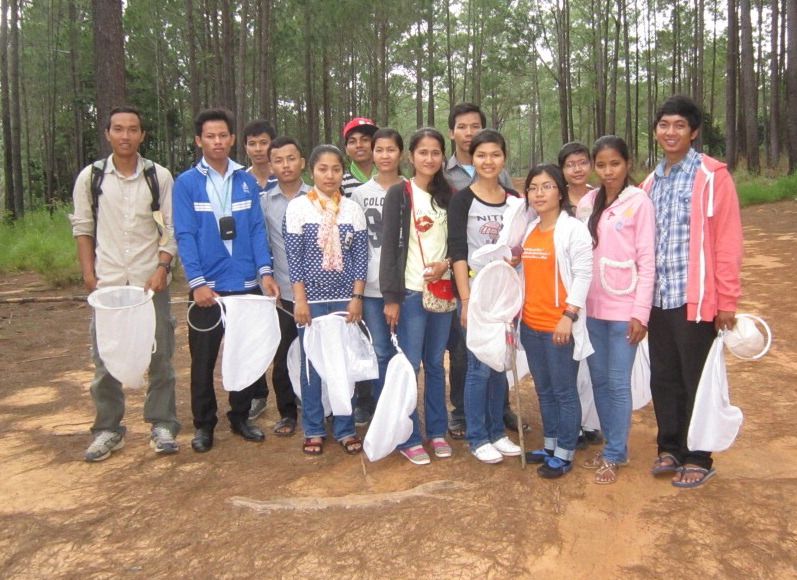
A dozen undergraduates from the Royal University of Phnom Penh join the project team on a field trip to collect leaf- and tree-hopper samples at Kirirom National Park. (Photo courtesy Dr. Phauk).
|
Over the course of this project, which ended as of December 31, 2016, Dr. Sophany Phauk and his large team of researchers and students conducted temporal biodiversity inventory assessments of
Membracoidea in every habitat type and along various grades of disturbance in Cambodia. As a result, they were able to assess the temporal biodiversity of not only
Membracoidea but also other insect groups in most habitat types, from agricultural land to national parks, covering more than 120 collecting sites in Cambodia. They have developed an extensive national entomology collection under the auspices of their newly created organization Cambodian Entomology Initiatives (CEI) and honed the curatorial skills of the 15 team members, who have gained valuable experience working with
Membracoidea and other groups such as
Lepidoptera, Coleoptera, Hymenoptera, Phasmatodea, and other arthropods. Through the PEER project, they also gained expertise in identifying indicator species for habitat health and/or disturbance, allowing rapid classification of habitat value for conservation and ecosystem services. A taxonomic study of insect pest species was another important component of the project, and the researchers have identified a genus of
Nephotettix and
Nilaparvata that are dominant taxa in rice paddies and other agricultural sites.
Participation in PEER also greatly enhanced the international linkages of the PI and his team. PEER funds supported a month-long training visit in 2014 by three team members to the lab of U.S. partner Dr. Chris Dietrich at the Illinois Natural History Survey (INHS), University of Illinois at Urbana-Champaign. In 2015, with support from the Fulbright visiting research scholar program, Dr. Phauk had the opportunity to spend three months with Dr. Dietrich for additional training and collaboration. During that stay, he received training on advanced classification techniques for
Membracoidea and worked with his partner on developing an entomology curriculum that was included in the overall undergraduate study program of the RUPP Department of Biology in late 2016. While in the United States, Dr. Phauk also made a brief visit to the Smithsonian Institution, where he established a working relationship with Dr. Stuart McKamey, a
Membracoidae expert at the Institution’s Systematic Entomology Laboratory. The PEER funding also facilitated the expansion of ties with Kasetsart University (Thailand), the Royal Belgian Institute of Natural Science, National University of Singapore, the Vietnam National Museum of Nature. The PI is working to develop future collaborations with the Natural History Museum in Vienna, the Museum für Naturkunde in Berlin, and Ateneo de Manila University.
As for future plans and activities, based on the results of this PEER project, the president of RUPP has committed to establishing a National Museum of Science at the university’s main campus, and the museum will include some of the materials in the entomological collection created by the PI and his group. The PI recently received a small grant from MaryKnoll - Cambodia to provide ongoing support for curators at the Cambodian Entomology Initiatives (Entomological Collection) and to design an Insect Garden space at RUPP. Thanks to another recent grant provided by the ASEAN-European Union Scientific Consortium for Interdisciplinary Biodiversity Research (SEABIO), Dr. Phauk also has support for a new project aimed at establishing linkages and promoting exchanges of experts from Cambodia, the Philippines, Thailand, and European institutions focusing on aquatic insect diversity. The PI and his colleagues are working on a manuscript on Hemipteran species that will be published for the first time for Cambodia in 2017, as well as a manual on Cambodian insects. The will also continue to maintain the CEI website (
https://www.cambodianentomology.org) and Facebook page (
https://www.facebook.com/entocollect).
Cambodian Entomology Initiatives flyer Rice-Field Experiment flyer Genetics Experiment flyer (Khmer)
Facebook



